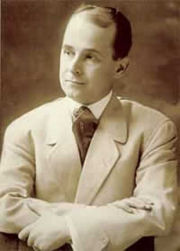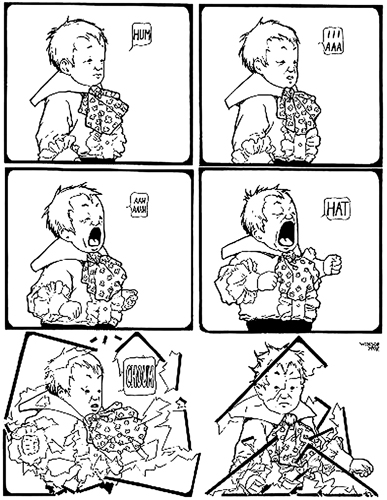<Back to Index>
- Military Physician Cosme Mariano Argerich, 1758
- Cartoonist and Animator Winsor McCay, 1869
- Imperial Foreign Minister of Austria - Hungary Ottokar von Czernin und zu Chudenitz, 1872
PAGE SPONSOR

Winsor McCay (September 26, 1869(?) – July 26, 1934) was an American cartoonist and animator.
A prolific artist, McCay's pioneering early animated films far outshone the work of his contemporaries, and set a standard followed by Walt Disney and others in later decades. His two best known creations are the newspaper comic strip Little Nemo in Slumberland, which ran from 1905 – 1914 and 1924 – 1927, and the animated cartoon Gertie the Dinosaur, which he created in 1914.
His comic strip work has influenced
generations of artists, including creators such as William Joyce, André LeBlanc, Moebius, Maurice Sendak, Chris Ware and Bill Watterson.
McCay was the son of Robert McKay (later changed to McCay) and Janet Murray McKay; Robert at various times worked as a teamster, a grocer, and a real estate agent. Winsor's exact place and year of birth are uncertain — he claimed to have been born in Spring Lake, Michigan, in 1871, but his gravestone says 1869, and census reports state that he was born in Canada in 1867. He was originally named Zenas Winsor McKay, in honor of his father's employer, Zenas G. Winsor. He later dropped the name Zenas.
In 1886, McCay's parents sent him to Cleary's Business College in Ypsilanti, Michigan, to learn to be a businessman. While in Ypsilanti, he also received his only formal art training, from John Goodison of Michigan State Normal College (now known as Eastern Michigan University). Goodison taught him the strict application of the fundamentals of perspective, which he put to significant use later in his career. Goodison, formerly a glass stainer, also influenced McCay's bold use of color.
In 1889, McCay moved to Chicago, intending to study at the Art Institute of Chicago, but due
to lack of money had to find employment instead.
He worked for the National Printing and Engraving
Company, producing woodcuts for circus and
theatrical posters. Two years later, he moved to Cincinnati, Ohio, and went
to work as an artist for Kohl and Middleton's Vine
Street Dime Museum. While in Cincinnati
he married Maude Leonore Dufour. McCay began doing
vaudeville chalk talks in
1906. In
his The
Seven Ages of Man vaudeville
act, he drew two faces and progressively aged
them.
McCay's first major comic strip series was Tales of the Jungle Imps by Felix Fiddle. Forty - three installments were published from January to November 1903, in the Cincinnati Enquirer. The strip was based on poems by George Randolph Chester, then a reporter and editor at the Enquirer. The stories concerned jungle creatures and the ways that they adapted to a hostile world, with individual titles such as How the Elephant Got His Trunk and How the Ostrich Got So Tall.
His strips Little Nemo and Dreams of a Rarebit Fiend were both set in the dreams of their characters and featured fantasy art that attempted to capture the look and feel of dreams. McCay's cartoons were never overwhelmingly popular, but always had a strong following because of his expressive graphic style. Newspaper pages were physically much larger in that time and McCay usually had a half a page to work with. For fantasy art in comics, his only rival was Lyonel Feininger, who went on to have a career in the fine arts after his comics days were over.
McCay also created a number of animated short
films, in which every single frame of each cartoon
(with each film requiring thousands of frames) was
hand drawn by McCay and occasionally his assistants.
McCay went on vaudeville tours
with his films. He presented lectures and did
drawings; then he interacted with his animated films,
performing such tricks as holding his hand out to
"pet" his animated creations.
The star of McCay's groundbreaking animated film Gertie the Dinosaur is classified by film and animation historians as the first cartoon character created especially for film to display a unique, realistic personality. In the film, Gertie causes trouble and cries when she is scolded, and finally she gives McCay himself a ride on her back as he steps into the movie picture.
In addition to a series of cartoons based on
his popular "rarebit" gags, McCay also created The Sinking of the Lusitania, a
depiction of the attack on the maritime ship. The
cartoon contained a message that was meant to inspire
America into joining World War I.
McCay died in 1934 and was buried at the Cemetery of the Evergreens in Brooklyn.
Woody Gelman discovered
many of the original Little Nemo strips at a cartoon
studio where Bob McCay, Winsor's son, had worked in
1966. Many
of the original drawings that Gelman recovered were
displayed at the Metropolitan Museum of Art under the
direction of curator A. Hyatt Mayor. In 1973, Gelman would
publish a collection of Little Nemo strips in Italy.

